It can be said that memories are often associated with certain places. The human mind relates each memory with a tangible element of the past, like objects, colors and places. The place of each individual’s dwelling is important for them and often they tend to relate their memories to them. Memories of a faraway childhood home never leaves our mind, as they encase our past in them and this past then forms our present. Once the house is no longer there, the displacement instigates identity issues. One reminisces about the perfect home of the past or the ‘not’ so perfect one. In both cases the individual forms an idea of a Utopian home and thus is plagued by the memories of the past. The remembering and forgetting and remembering and filling the missing gaps become a part of us. An individual’s house is the most secure place in their lives and they all desire for it to fulfill their notion of perfection. The relationship between the past and present helps conceptualize spaces and places and perfection is tried to achieve.
Thursday, April 18, 2013
Individual memories and Narrative.
Anna Green's article discusses individual remembering and collective memories. She questions if these individual memories are significant in any way and can they challenge dominant memories?
Why would they not be important? Individual memories are significant as together, several of these form a collective memory of a society. This collective memory becomes a part of the oral history of a nation which is important to trace the events of the past.
What is oral history? The best way to describe it is that “it is the contribution of memory in historical research” (Bornat 1). History is the focus on recording certain events in a particular way and oral history focuses on recording memories of individuals, reminisced and narrated by them as they interpret it. Through oral history one is able to draw out a memory and gain a better “understanding of the past experienced both individually and collectively” (Bornat 2). Bornat also explains in her essay that oral history relays the events of history with a better understanding of the social processes by culture, class and gender.
Our memories are important to us as they stay with us for as long as we live. Be they haunting memories, good memories or sad memories, they always have an impact on the human mind. The memories live with us. Sometimes one cannot rid of these memories until they are relayed to others. When recording oral history, memories play a significant role as the details observed and remembered by each individual are different. Every individual chooses to remember what is significant to him and all these memories together help record the events and details that otherwise go unnoticed. For example, the events of the 1947 India, Pakistan partition narrated by individual are different as they narrate only the part which has left an impact on their minds therefore one gets an insight into the minds of individuals and communities of a society. Undoubtedly it is challenging to accurately transfer memories into something tangible. When it comes to recollection oral history can vary but it becomes almost accurate if the documentation is personally more important or significant to the narrator. Therefore it is an important medium of documentation of history and memories.
Why would they not be important? Individual memories are significant as together, several of these form a collective memory of a society. This collective memory becomes a part of the oral history of a nation which is important to trace the events of the past.
What is oral history? The best way to describe it is that “it is the contribution of memory in historical research” (Bornat 1). History is the focus on recording certain events in a particular way and oral history focuses on recording memories of individuals, reminisced and narrated by them as they interpret it. Through oral history one is able to draw out a memory and gain a better “understanding of the past experienced both individually and collectively” (Bornat 2). Bornat also explains in her essay that oral history relays the events of history with a better understanding of the social processes by culture, class and gender.
Our memories are important to us as they stay with us for as long as we live. Be they haunting memories, good memories or sad memories, they always have an impact on the human mind. The memories live with us. Sometimes one cannot rid of these memories until they are relayed to others. When recording oral history, memories play a significant role as the details observed and remembered by each individual are different. Every individual chooses to remember what is significant to him and all these memories together help record the events and details that otherwise go unnoticed. For example, the events of the 1947 India, Pakistan partition narrated by individual are different as they narrate only the part which has left an impact on their minds therefore one gets an insight into the minds of individuals and communities of a society. Undoubtedly it is challenging to accurately transfer memories into something tangible. When it comes to recollection oral history can vary but it becomes almost accurate if the documentation is personally more important or significant to the narrator. Therefore it is an important medium of documentation of history and memories.
It helps in interpreting the society and its thoughts about different situations of the past by drawing out their memories. Joanna Bornat quotes Robert Miller in her essay about oral history that it gives an understanding of the individual’s conscious and subconscious which composes a story that pleases the teller. It can be deduced from the readings that reminiscing the past is an essential part of recording oral history which relies on memories. Memories surround us and reminiscing is an everyday activity for an individual but when encouraged at a group level, it can bring about a change. It can be undoubtedly stated that individuals are willingly express themselves while narrating because it is like a life review which gives them a new and better self-understanding. Bornat’s understanding that language, meaning and memory interacts and mediate the structural determinants of society today and in the past is quite logical. Through the combined memories of these individuals much can be deduced of the lifestyle and societal structure of their pasts and how it has come about to be what it is in the present.
Wednesday, March 27, 2013
Home is a foreign place
The
word ‘Home’, is attributed to a place of comfort-a place which is familiar to
us in every aspect but Zarina Hashmi, titles her work, ‘Home is a foreign
place’. Most of her works, like, ‘Dividing
Lines’, ‘Cities I Called Home’
and ‘Home is a Foreign Place’ deal
with the issues of displacement due to partition or new boundaries being
created. Apart from displacement she also works with the themes of memory and
traveling. Although these themes are the central focus of many other artists’
works, Zarina Hashmi is significantly known for it. The art work chosen to be
discussed in this paper is titled, ‘Home
is a Foreign Place’.
Zarina’s
works are like her personal journal reflecting the events of her life as she
travels to different places. The effects of this dislocation are brought
forward through very refined mesh of diagrams and maps which capture the memory
of an event, an emotion, a place and its ambiance. In an interview, while talking about her work
Zarina says:
“I
was born and grew up in India; my eye was trained by what I saw around me. The
last fifty years I have spent looking at other cultures, I have learned a lot
from those encounters. Nevertheless, I have emotionally come back to where I
started.
I consider myself a contemporary artist, like many others artists of my
generation who were born in one place and live in other places. My work is a
synthesis of all the traditions I passed through.”
This
specific work comprises of 36 different remnants of memory depicted on wood and
placed together as a wall installation. The fragments of her memory emanate a
strong feeling of nostalgia. There is a presence of emptiness in these simple
linear drawings. Trained in printmaking,
Zarina uses this technique on both paper and wood, which she herself carves.
Wood is an interesting medium to be used as it is a largely used material in
our homes-it is a part of the basic structure of a house. Wood makes one feel
nostalgic as the smell and the feel of the surface makes one travel into a
different time and place. On the other hand, even though paper is not a very
durable material but it is used for mapping and tracking history. In a way, Zarina Hashmi is tracing her own
history with places she has lived in, through her drawings; mapping them and
installing them together as she remembers them in fragments just like parts of
memories are remembered and associated with certain places. There is a
connection between all her works-they follow the same path created by her web
of drawings. Although,
her drawings are minimalist, they reflect emotions and strong expressions. The
bold black ink lines say much more than a busy painting, the feeling of loss
being dominant in all of these works. The impact of the India-Pakistan
partition is predominantly reflected in her works. Her work is a great example
of an art work that reflects feelings of both physical and mental displacement,
memory, traveling and nostalgia in a very refined and minimalist way-her use of
monochromatic ink expresses emotions much more dynamically than an array of
vibrant colors.
Saturday, March 9, 2013
Memories
Memories of our pasts live with us in fragments, throughout our present. Our homes are consumed by our memories just like a closet holds our secrets together serving as a recollection of overlapping reminiscences of our past and present. Fragments of our memories help is gain a better understanding o our past experiences both individually and collectively. We tend to relate these memories to a certain place or space that we inhabited at that time.
Remembering and forgetting, remembering and filling the missing gaps become a part of us. This relationship between past and present helps in conceptualizing spaces and places to achieve perfection in them.
Remembering and forgetting, remembering and filling the missing gaps become a part of us. This relationship between past and present helps in conceptualizing spaces and places to achieve perfection in them.
Thursday, March 7, 2013
Wednesday, March 6, 2013
Home
It is in the human nature to feel a sense of belonging to a certain space-a space that they can refer to as 'home'. It is not just a need for human beings but animals also tend to be protective of the spaces they inhabit. Our identities are place- bound being defined by the places we dwell in. A nation is known by its country, a community by the are it lives in and an individual, by his own personal space.
The spaces that we tend to spend most of our time in are consumed by our presence in many ways, mirroring several shades of our personalities. It is difficult to define one particular space as 'home'. Home is a place that overwhelms us with the feeling of nostalgia-we share our memories with it and our secrets too-holding fragments of our past and present together in one place. This space is the most honest reflection of our self. The objects and furniture a enclosed within these spaces, portray our presence.
The spaces that we tend to spend most of our time in are consumed by our presence in many ways, mirroring several shades of our personalities. It is difficult to define one particular space as 'home'. Home is a place that overwhelms us with the feeling of nostalgia-we share our memories with it and our secrets too-holding fragments of our past and present together in one place. This space is the most honest reflection of our self. The objects and furniture a enclosed within these spaces, portray our presence.
Wednesday, February 20, 2013
Vicky Ambery Smith
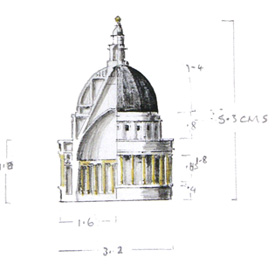
British Jewellery Designer, Vicky Ambery Smith creates delicate and small-scale ornate boxes and jewellery inspired by real and imaginary buildings. By replicating these buildings in miniature forms she creates an interesting study of space and light. It gives her work a personal character allowing the viewer to create their own narrative behind each piece.
Brooches
Earrings
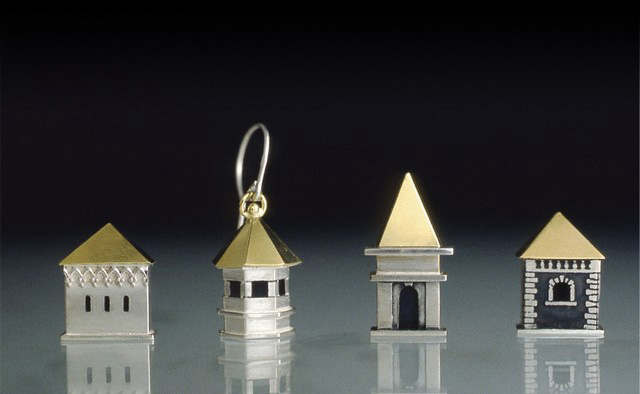
Rings

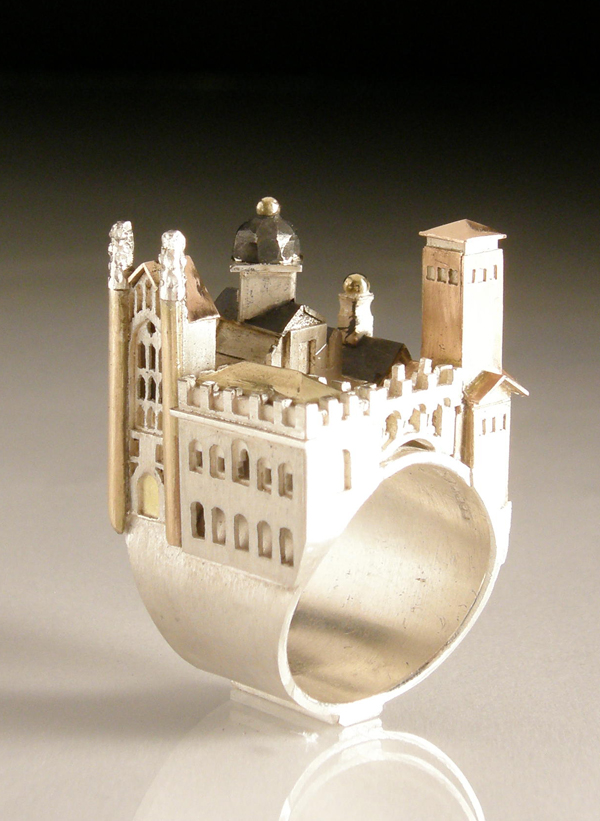



Boxes

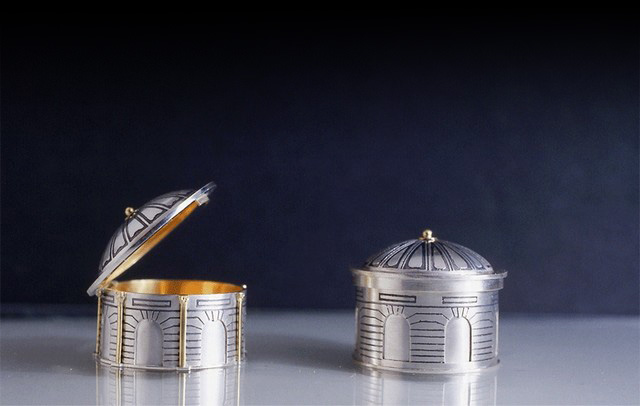
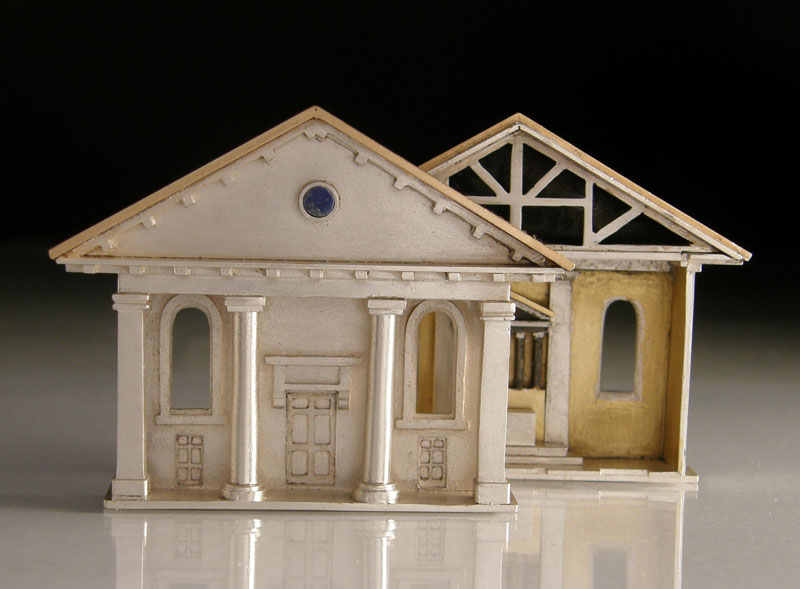
Creating spaces of memory
Silent film actress, Colleen Moore got much more fame through a dollhouse, than she did from her film career.
For a collector—and I mean a real collector, a collector as he
ought to be—ownership is the most intimate relationship that
one can have with objects. Not that they come alive in him; it is
he who lives in them.
—Walter Benjamin, Illuminations
ought to be—ownership is the most intimate relationship that
one can have with objects. Not that they come alive in him; it is
he who lives in them.
—Walter Benjamin, Illuminations
The dollhouse was created by the actress and her father, over a time period of seven years. Now known as 'Colleen Moore's Fairy Castle', the dollhouse traveled throughout the United States and Canada in the 1930s to raise money for charity. Since then it has been a popular attraction at Chicago Museum of Science and Industry.It has been discussed as a historical narrative as it is considered a remnant of a particular time and place.
The dollhouse has two dominant motifs: wealth and nostalgia. It presents a myriad of perfect objects that are, as signifiers, often affordable, whereas the signified is not. . . . Use value is transformed into display value here. Even the most basic use of the toy object—to be “played with”—is not often found in the world of the dollhouse. The dollhouse is consumed by the eye.
-Susan Stewart
Details of the dollhouse
The artist used her personal belongings like her hat pins and diamond rings, in the interior of the dollhouse.Amelie Hastie states in her article about the dollhouse that Moore anticipates both the loss of her history and eventual retrieval of it through this dollhouse, inviting the historian to reawaken and re-present the various relations preserved in this collection.
As Stewart notes, a dollhouse is not a toy to be
played with; rather, it “is consumed by the eye.” Certainly this definition
would not apply to most dollhouses—those owned by families and not housed in
museums—for those toys have a real tactility, and their function is to be
played with as well as to produce certain narratives about the “home.”
Subscribe to:
Posts (Atom)















.jpg)
.jpg)
.jpg)
.jpg)



.jpg)
.jpg)
.jpg)
.jpg)
.jpg)
.jpg)

















